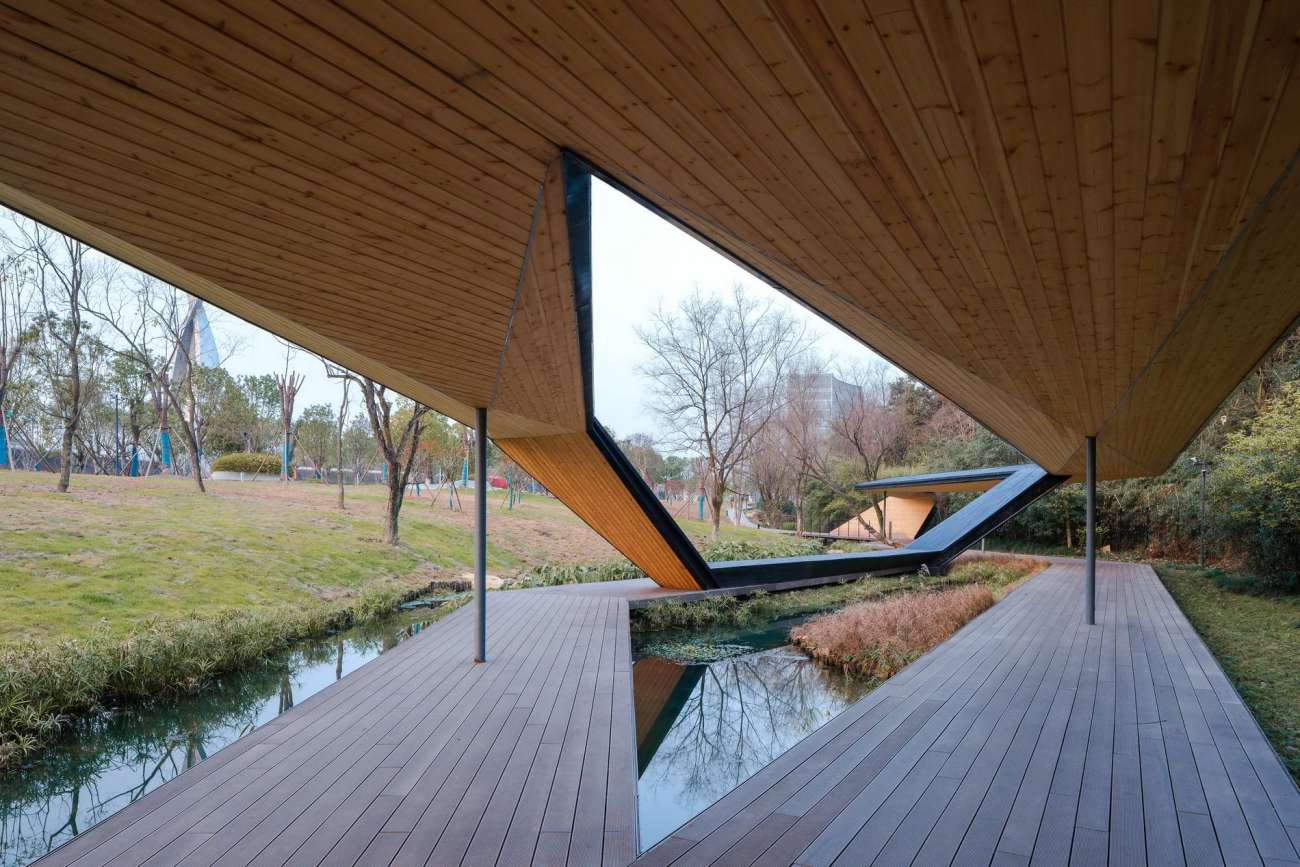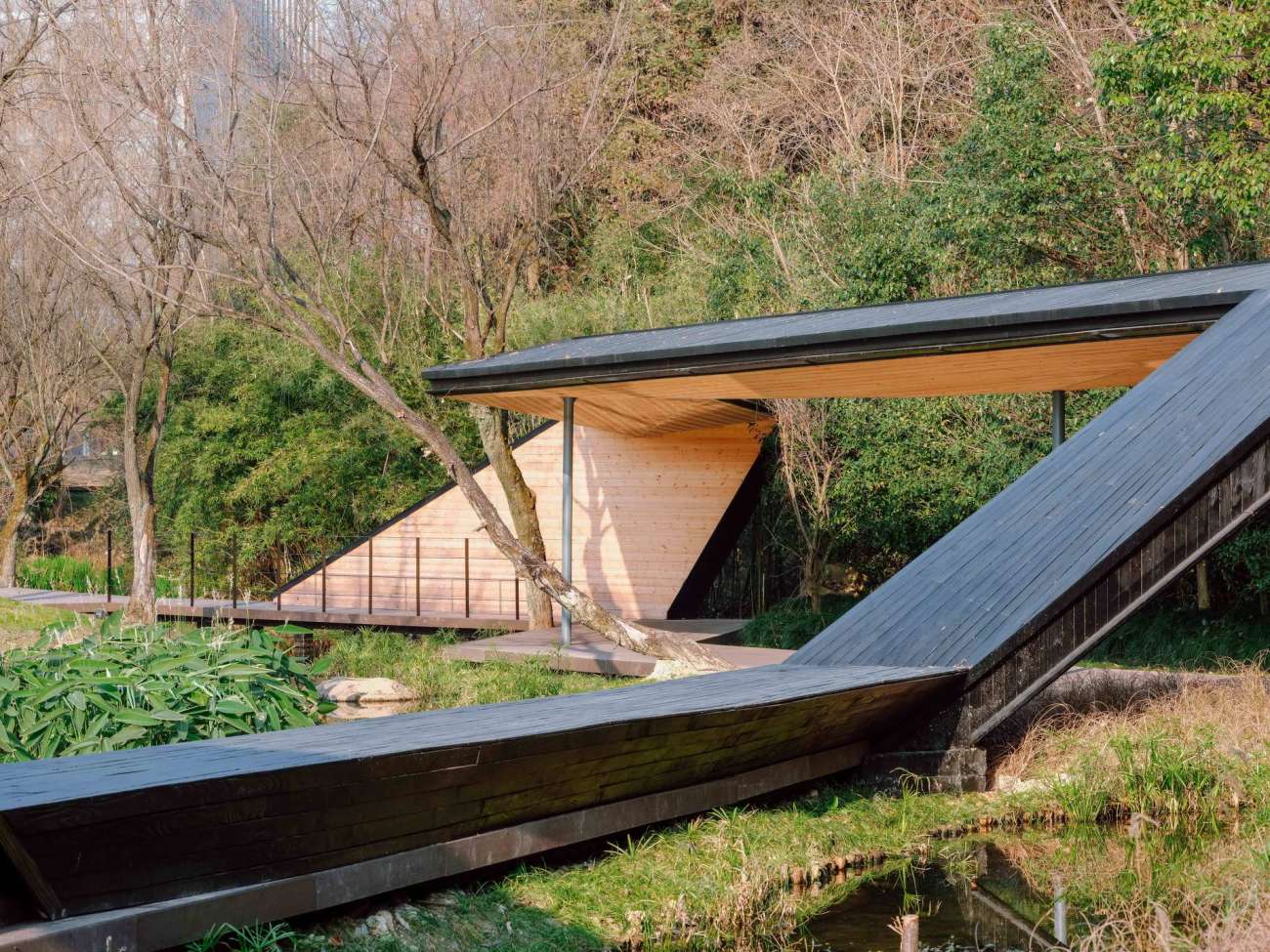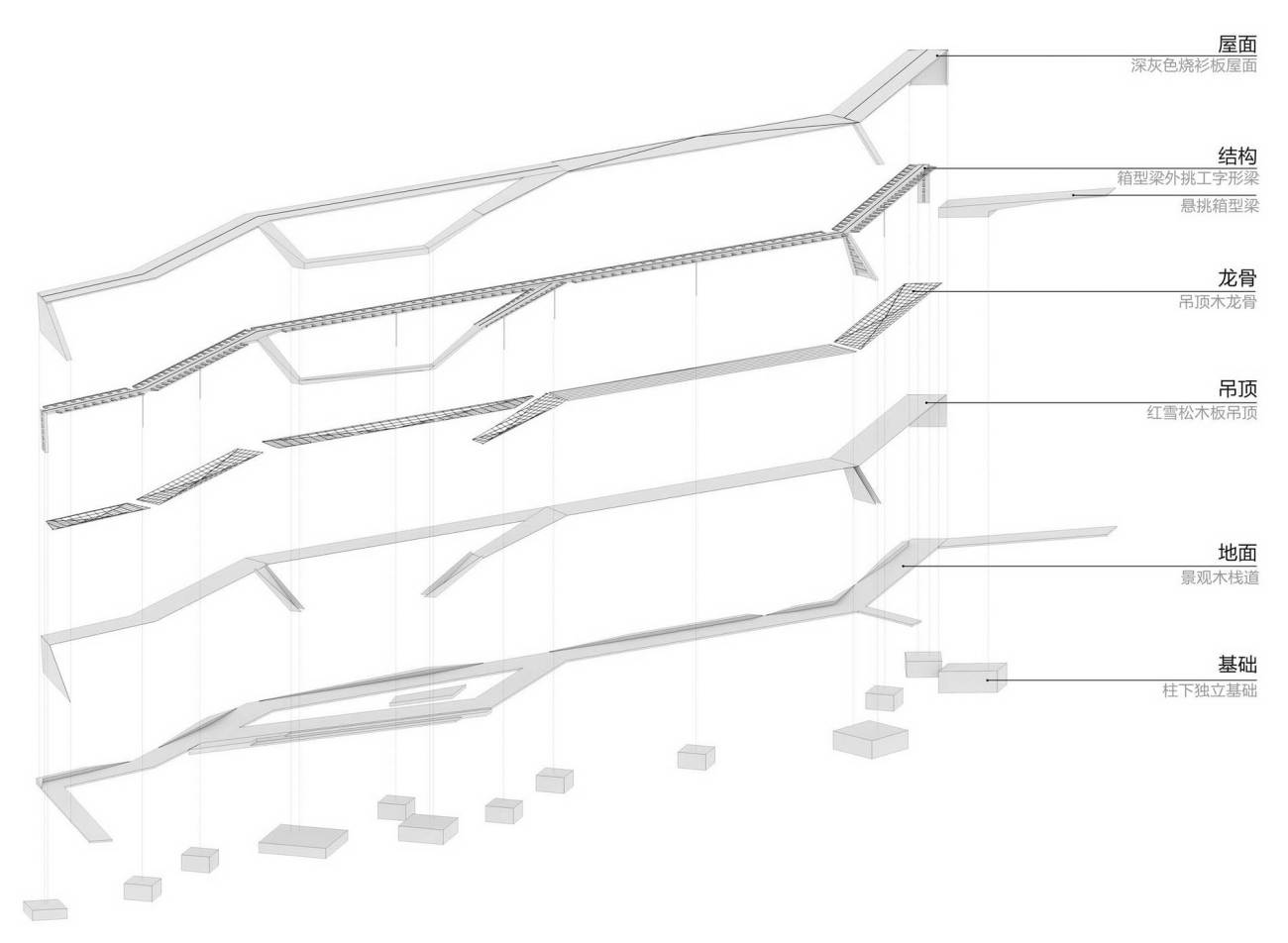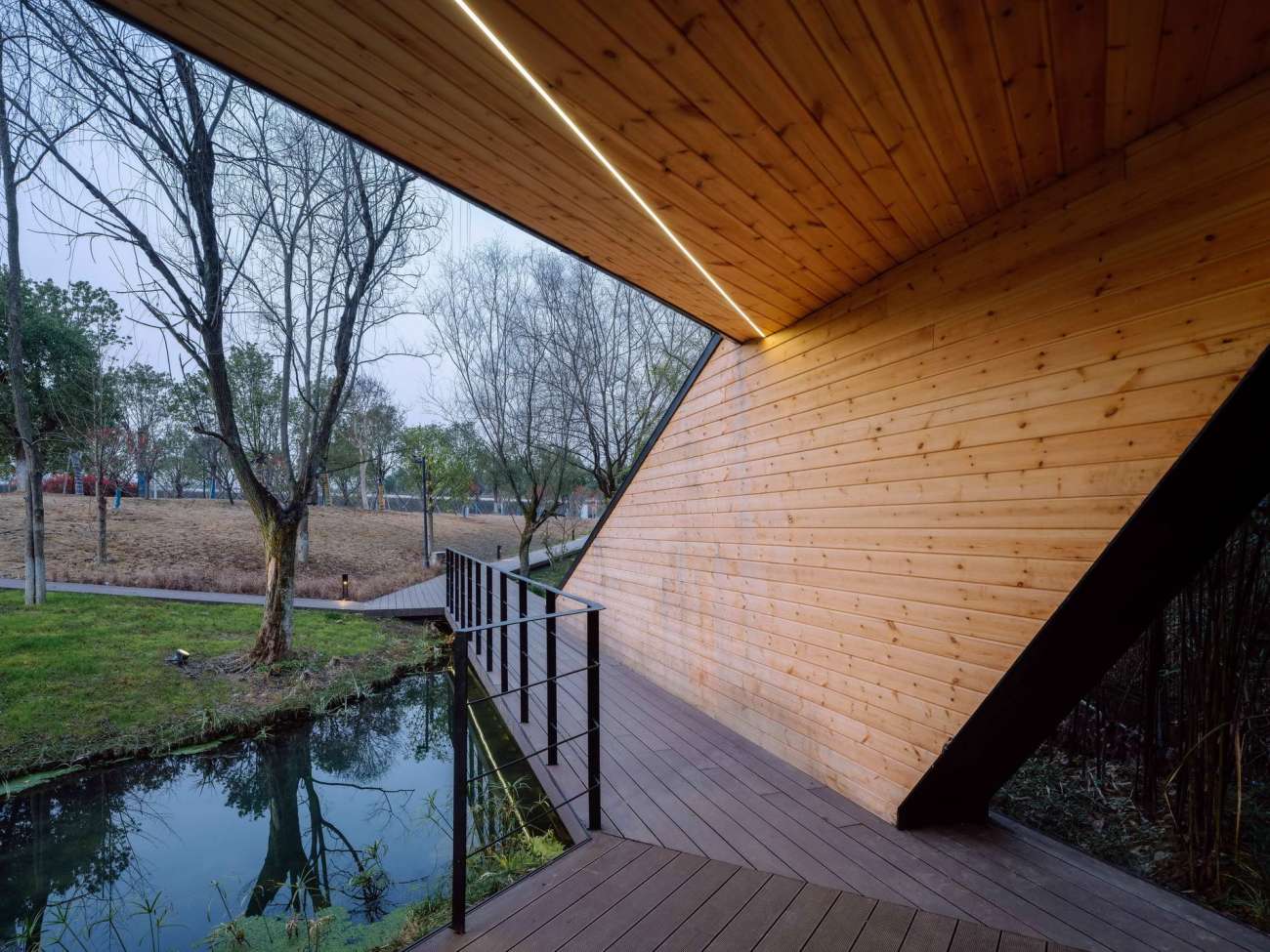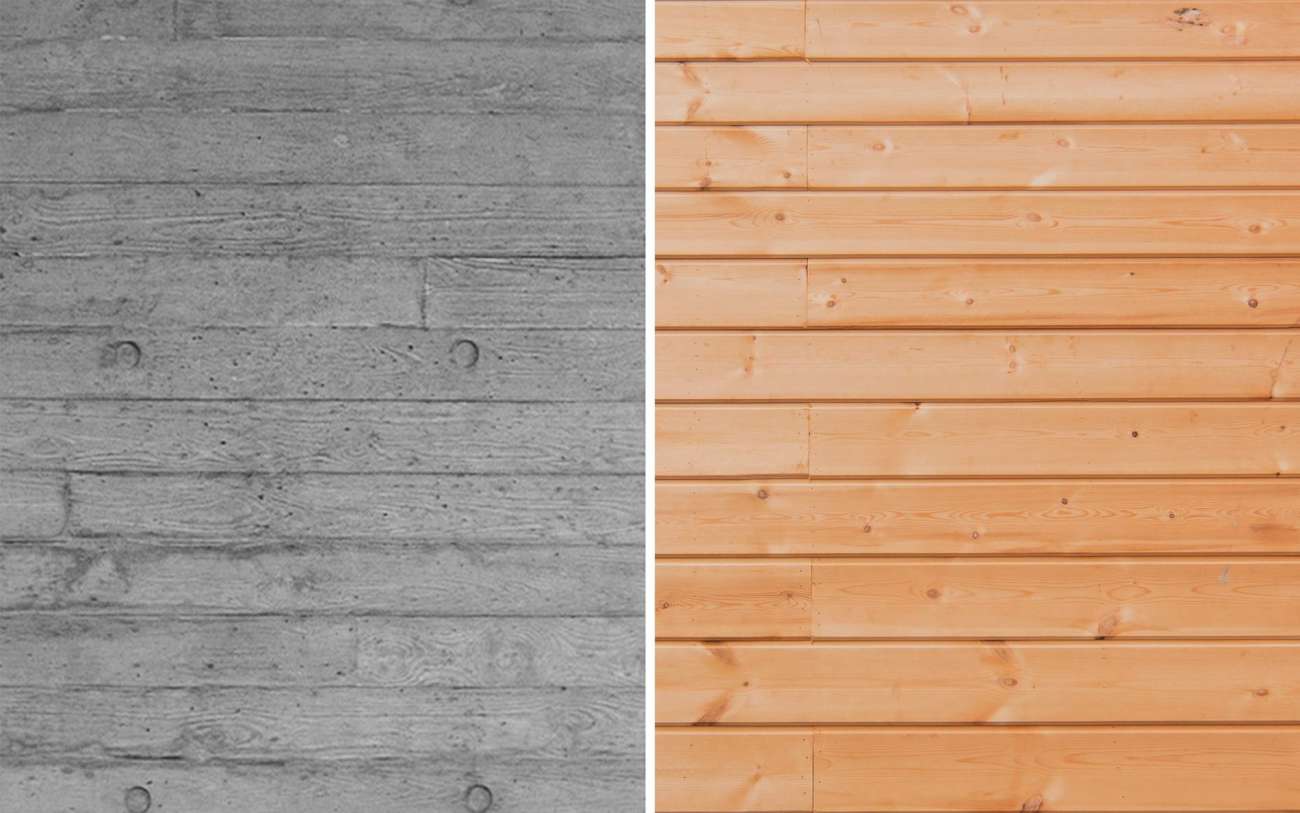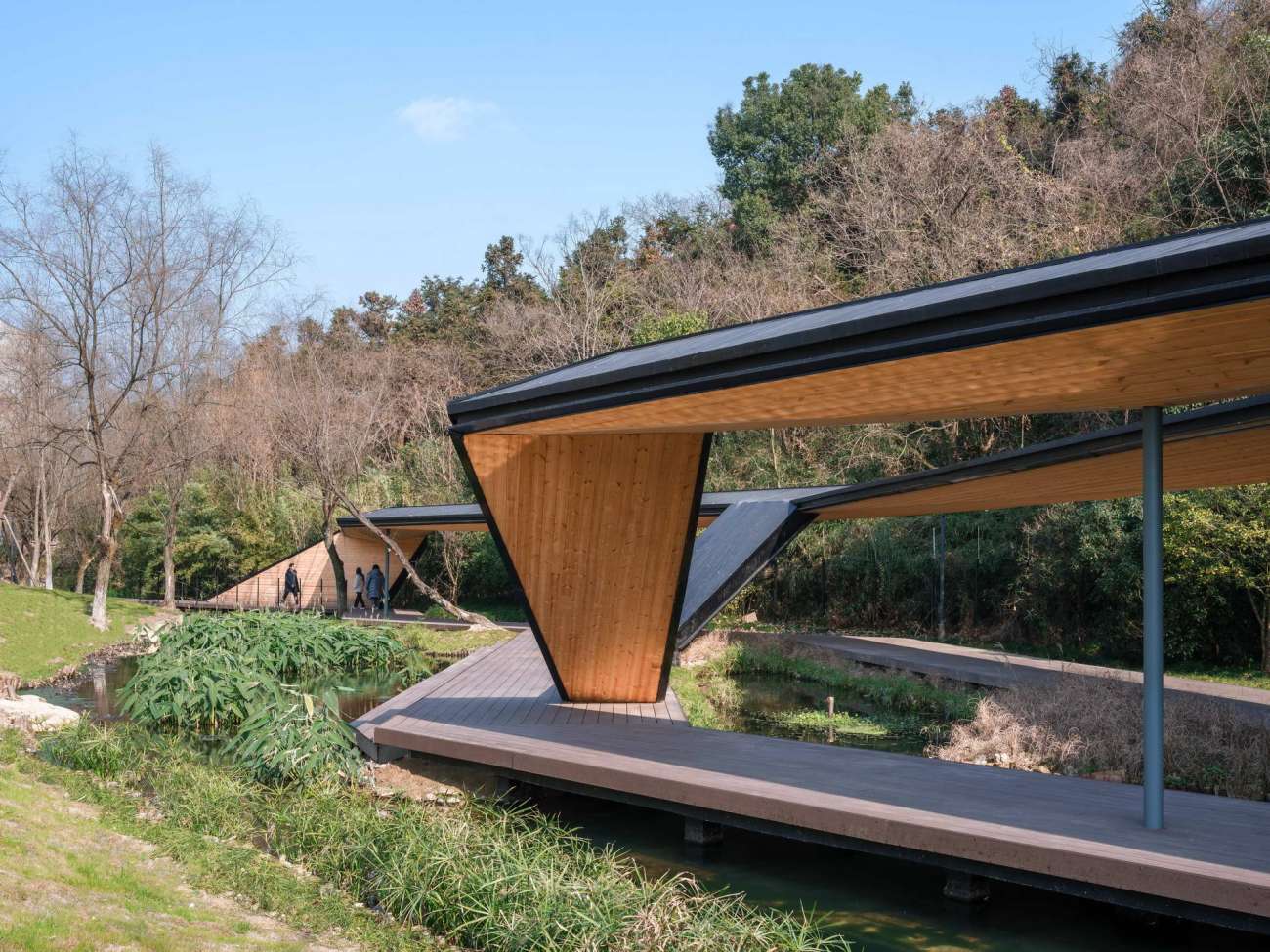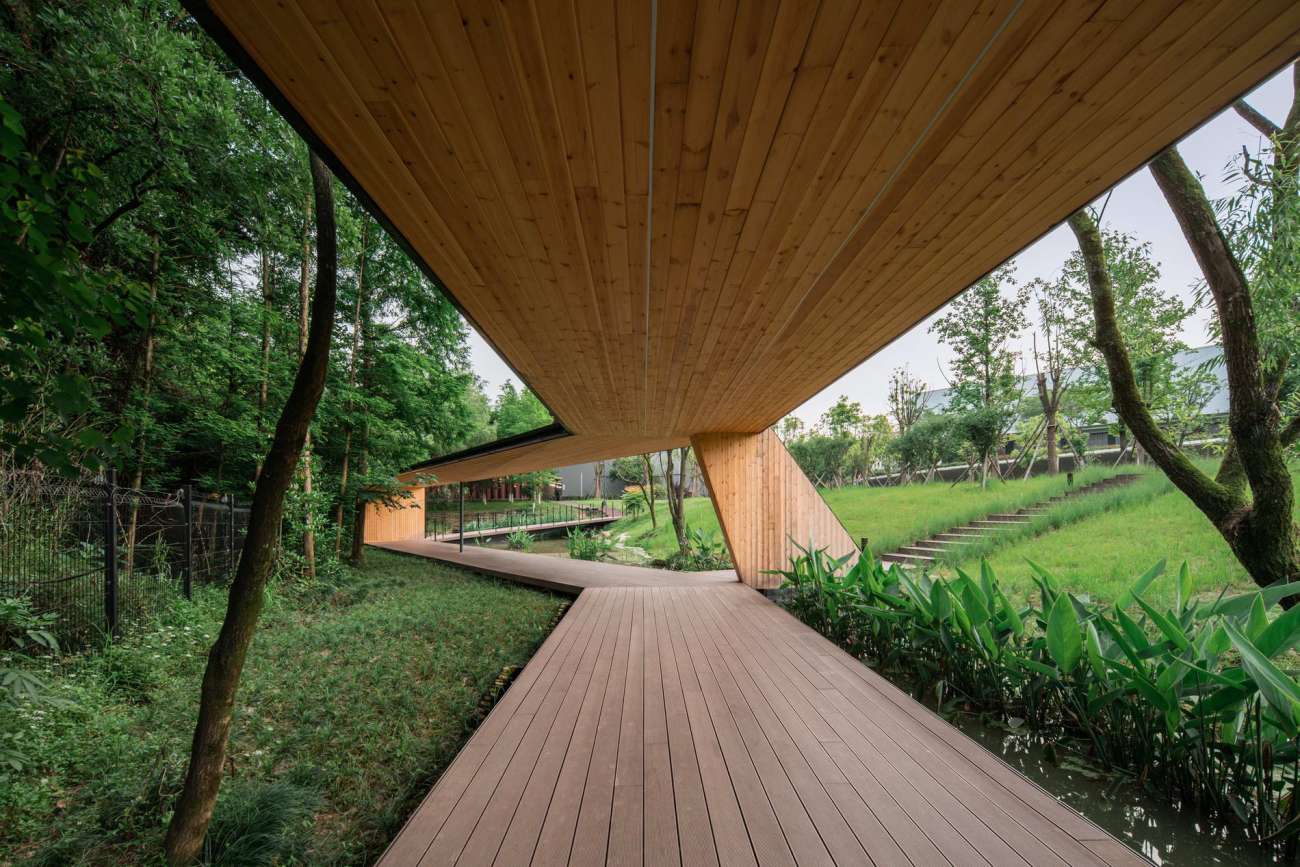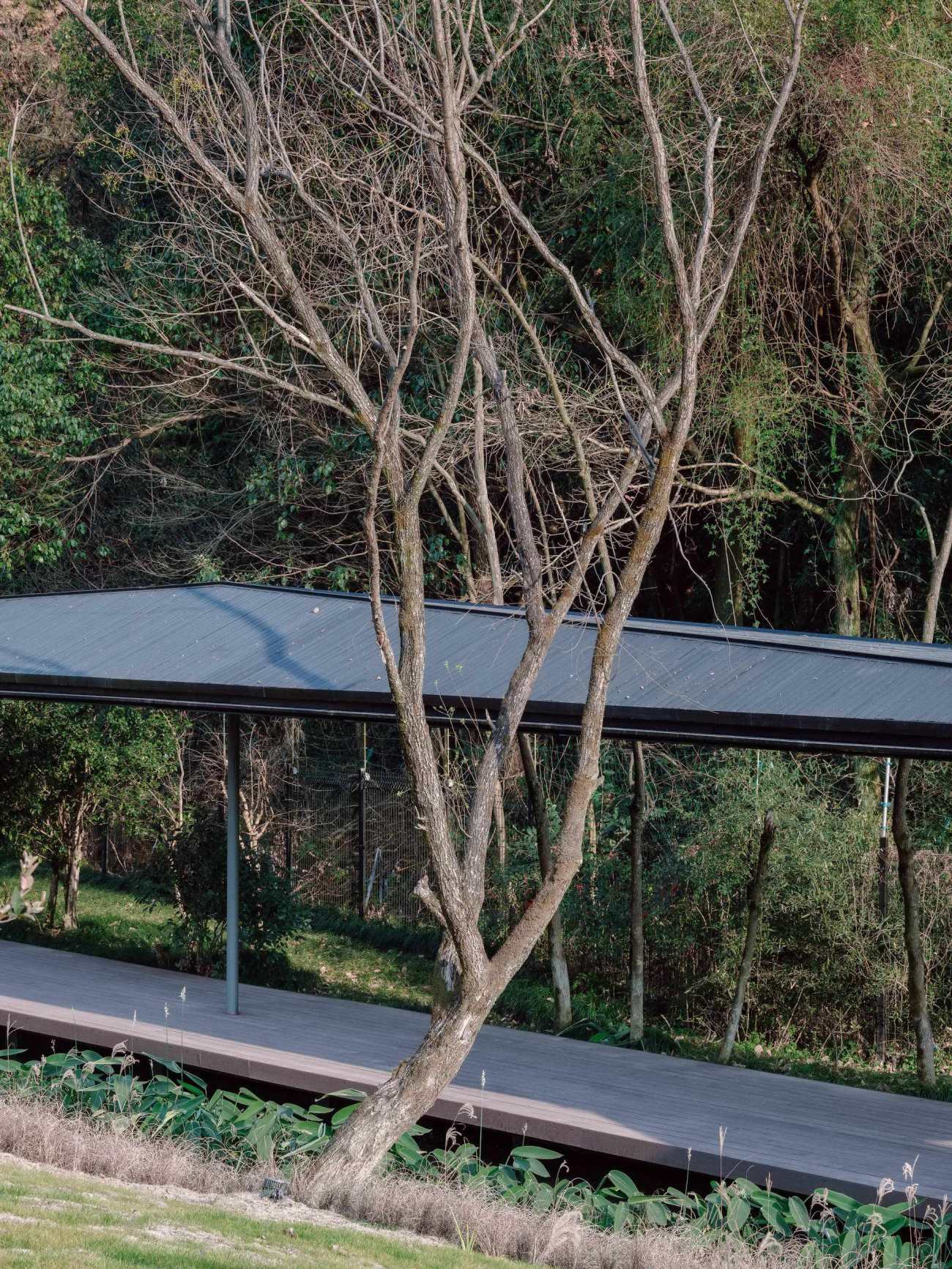自然充满着时光的形象,自然栖留,而时光飞速滑行。—— 荷尔德林《远景》
Nature is full of the image of time, nature stays, and time flies.—— By Holderlin in the Vision
“溪上飞檐”所在的浙江音乐学院,是中国第 10 所独立设置的专业音乐教育高等院校。在十年前的设计竞赛之时,基于对当下常规的被围墙所包围的封闭式式高校格局的反思,主创建筑师朱培栋即尝试以“开放的音乐艺术公园”为空间场景的原型,并以“流动地景、隐山乐居”——这一地景化和聚落化的形式操作来跳脱传统的大学校园尺度和界面,寻求一种更具自由性和开放度的艺术院校建设新模式。
Zhejiang Conservatory of Music, where " Floating Cornice on the Brook” is located, the country's tenth and only newly constructed professional music education college. At the time of the design competition ten years ago, reflecting on the current pattern of conventional enclosed universities surrounded by walls, Zhu Peidong, the Chief Architect, has tried to take "an Open Music Art Park" as a new spatial prototype, and operated in the form of landscape and settlement namely "Flowing Landscape, Hidden Mountain Residence" - the operation of this landscape and settlements – to breaks away from the scale and interface of the traditional university campus to seek a more free and open new spatial prototype of art college construction.
△ 以“开放的音乐艺术公园”为空间场景的原型
△ 流动地景 隐山乐居
而当2015年校园建成投用以来,随着校园软硬件的逐渐磨合,运维管理水平的提升,院校管理团队逐渐起意将校园整体申报4A级文化旅游景区,从而为我们提供了以校园微更新的方式,延续当年设计初心的实践机会,助力校园实现从设计理念层面的“开放校园”到社会生态层面的“公共景区”的身份维度拓展。
Since the campus was built and put into use in 2015, with the gradual running-in of the campus software and hardware supports, and the improvement of the operation and maintenance management level, the management team of the college decided to declare the whole campus as a 4A cultural tourist attraction. Thus, it provides us with a practice opportunity to continue the original intention of design in the form of campus micro-renewal, and helps the campus to expand its identity dimension from the "open campus" at the design level to the "public scenic spot" at the social and ecological level.
| 01 |
线性嵌入:串联南北
Linear Embedding: North-South Connecting
浙音校园建筑布局随用地形态,分为南北两大组团,形态特征鲜明。北侧是嵌在山地中的自然地景建筑,南侧的是人工边界明确的礼仪性空间,设计在中部留白,以流动的曲线形走道、蜿蜒的沿山渠和自然景观连接南北校区。
The layout of campus buildings varies with the land use and is divided into two groups, north and south, with distinct morphological characteristics and distinction. On the north side, it is the natural landscape architecture embedded in the mountain and on the south side,it is the ceremonial space with clear artificial boundaries. The design leaves the middle part blank, connecting the north and south campus groups with flowing curving walkways, meandering channels along the mountain and natural landscape.
△ 双廊并行,串联南北
作为校园评定4A景区的重要基础设施提升,强化校园中段的公共属性,激活既有的校园空间成为我们这一开放式微更新的命题目的。
As an important infrastructure upgrade for the campus 4A scenic spot evaluation, strengthening the public attributes of the middle section of the campus and activating the existing campus space have become the proposition purpose of our Open-ended micro-renewal.
通过对当年我们旧有设计意图的回溯,结合当下的校园内外发展的新需求,我们最终选址在校园中段原生态留白的沿山渠雨水花园处,以对场地最小干预的方式,新增嵌入一条线形的人行漫步系统。
Through the retrospection of our original design intention at that time, combined with the current new needs of development inside and outside the campus, we finally selected the rainwater garden along the mountain canal in the middle section of the campus, which was originally left blank, and embedded a linear pedestrian system with minimal intervention approach on the site.
△ 场地原貌
借由中国传统绘画散点透视的创作手法,转译古典园林“栈、廊、檐、桥”的空间元素,我们尝试在折廊的纵深空间内,将多个视线焦点、空间形式以及行为场景进行叠合,使得人们在行走与观览中,获得迂回且多元的空间体验与阅读视角,意图实现这一板块校园既有低效闲置空间的激活,以及校园公共漫游体验的提升。
Borrowing from the traditional Chinese painting technique of scattered perspective and translating the spatial elements of "Plank, Corridors, Cornice, Bridges" of classical Chinese gardens, we try to superimpose multiple focal points, spatial forms and behavioral scenes in the longitudinal space of Floating Cornice on the Brook, so that people can gain a circuitous and diversified spatial experience and reading perspective when walking and viewing, aiming to activate the existing inefficient vacant space in this section of campus and improve the campus public roaming experience.
△ 散点透视分析
飞檐北侧以轻轻浮于地表的木栈道作引,衔接了沿山消隐、余音缠绕的音乐系楼;南侧则以单边悬挑的钢桥和台基收尾,直面线性匍匐、人间烟火的校园食堂,从而完形了望江山麓的自然步径,为校园师生和外来访客提供了穿林跨溪的校园南北步行新体验。
On the north side of Floating Cornice on the Brook, the wooden plank path gently floating on the ground is used as the guide, connecting the music department building which fades along the mountain and entwines with the remaining sound; On the south side, it ends with the unilateral cantilevered steel bridge and platform base, facing the campus canteen that linear spread out on the ground. Thus, it has formed the natural walking path at the foot of Wangjiang Mountain, providing a new experience of walking from north to south of the campus through woods and Brooks for teachers and students and visitors.
△ 连接校园南北的步行新体验
| 02 |
双廊并行:东西对话
Parallel Corridors: East-West Dialogue
在校园中部边界,新生的“溪上飞檐”与已投用多年的“音谷云廊”双廊并行,融入校园中部自然山景,形成能够诱发多元日常行为的校园公共空间体系。十年前的音谷云廊因应校园的整体理念,强调了曲线柔和的形态和流动地景的设计切入点,清水混凝土的坚实体量下蕴含木纹转印的细腻肌理,并在当下构成了我们进行校园微更新的既定设计基础条件。
In the boundary of the campus’ central part of, the newly-built Floating Cornice on the Brook and the Cloud Corridor in the Valley of Music, which has been in use for many years, are parallel, integrating into the natural mountain scenery in the middle of the campus, forming a campus public space system that can induce diversified daily behaviors. Ten years ago, Cloud Corridor in the Valley of Music was designed in accordance with the overall concept of the campus, emphasizing the design entry point of soft curves and flowing landscape. The solid volume of fair-faced concrete contains the delicate texture shaping by board grain, and at present constitutes the established design basis for our campus micro-renewal.
而此次新增东侧钢木折廊“溪上飞檐”与西侧混凝土连廊“音谷云廊”一轻一重,一虚一实,一折一曲,一柔一刚,以不同的方式,共同串联了校园南北,并在彼此的形式与地形、结构与材料上形成跨越十年的对话,完形了浙江音乐学院面向中部自然山体和缓坡地貌的消隐边界。在连廊之间,顺应校园的流动空间结构,景观呈现几何线性形态,景观道路与连廊像旋律与音符,引导着人群在校园间动态行进。
The new steel and wood folding corridor Floating Cornice on the Brook on the east side and concrete corridor Cloud Corridor in the Valley of Music on the west side are added. One is light and the other is heavy, one is virtual and the other is real, one is folding and bending, one is soft and the other is rigid. They connect the north and south of the campus in different ways, and form a dialogue spanning over a decade in the form and topography, structure and materials of each other. They form the hidden boundary of Zhejiang Conservatory of Music facing the Natural Mountain and gentle slope landform in the middle. In the corridor, in line with the flowing space structure of the campus, the landscape presents a geometric linear shape. The landscape road and corridor are like melody and notes, guiding the crowd to move dynamically across the campus.
△ “溪上飞檐”与“音谷云廊”形成跨越十年的东西对话
△ “溪上飞檐”南北视角
| 2.1 拓扑的关系 |
Topological Relations
跨溪穿林 / 蜿蜒徐行
Crossing the Brook and through the Trees / Meandering along the campus boundary
“音谷云廊”以半开放清水混凝土廊道形成声障,而溪上飞檐”以全通透钢木折廊引山入园。混凝土连廊曲线灵动,钢木折廊曲折笃定,两种材质的廊道因循着各自地形特性,诠释流动走道的两种形态。
Cloud Corridor in the Valley of Music forms barrier blocking the noise with half-open fair-faced concrete corridor, while the Floating Cornice on the Brook leads the mountain into the garden with fully transparent steel and wood folding corridor. The concrete corridor curve is soft and steel and wood folding corridor twists and turns with distinct nodes. The corridor of the two materials follows their own terrain characteristics to interpret the two forms of the corridor.
△ 流线与植被分析
△ 东侧曲折笃定的“溪上飞檐”和西侧曲线灵动的“音谷云廊”
“音谷云廊”原场地东西两侧有1至4米不等的高差,外侧为校园与城市车行道。相较于呆板的挡土墙,连续悬挑的半拱形风雨连廊既屏退车行噪音干扰,又诗意地构建起遥看望江山景、遮蔽风雨的交通空间,其后屋面覆土而融入地景,柔化了校园东侧边界。line+的微更新在这一侧完整保留了原有的空间设计关系,仅做了景观植物的替代,营造了由33棵早樱构成的樱花林。
There is a height difference of 1 to 4 meters on the east and west sides of the original site of Cloud Corridor in the Valley of Music, and the outer side is the campus and the urban roadway. Compared with the monotonous retaining wall, the semi-arch wind and rain corridor cantilevered continuously not only eliminates the interference of traffic noise, but also poetically builds a traffic space to overlook the distant scenery of mountains and shelter the wind and rain. The roof is then covered with soil to blend into the landscape, softening the eastern boundary of the campus. The micro-renewal design implemented by line+ preserves the original spatial design relationships and landscape texture replaces the original landscape plants by a cherry grove consist of 33 early cherry trees.
△ 双廊剖面
△ 柔化校园东侧边界的音谷云廊
沿“音谷云廊”向西望去为望江山,其脚下的“溪上飞檐”贴合山缘,跨溪曲折前行,由“栈、廊、檐、桥”复合叠形,融合倚山、淌水、临溪、曲径等空间片段所承载的行为场景,营造多元而复合的空间体验路径。
Looking west along the Cloud Corridor in the Valley of Music, there is Wangjiang Mountain. At its feet, the Floating Cornice on the Brook along the mountain edge, zigzagging forward across the Brook, compound by the spatial elements of "Plank, Corridors, Cornice, Bridge", and integrating the behavioral scenes carried by walking along the mountain, paly with water, walking along the brook and winding paths, creating a multiple and composite spatial experience path.
栈——为避免对场地原生环境的侵扰,采用跨溪架空的方式,尽量伏低贴近水面,每一折都避开原生乔木,并贴合山体的坡向走势。
Plank: In order to avoid the disturbance to the original environment of the site, the folding corridor is elevated above the brook, as close to the water as possible, avoiding the native trees in each folding, and fitting the trend of the mountain.
廊——栈之上立柱架檐,顺应山缘驳岸之势弯折,并于中部折廊入溪,行人落步三两阶即可闲坐溪面,融合坐立、观看及漫步功能,营造动静相宜的共享休憩场所。
Corridor: roof float on and columns stand on the plank to form a corridor, which bends in accordance with the trend of the mountain edge and the bank, folds middle part into the brook for pedestrians take several steps to sit next the brook. Corridor integrate the functions of sitting, watching and strolling, which creating a shared leisure place.
△ 由“廊”落步三两阶,行人即可闲坐溪面
檐——简化传统坡屋顶中脊与檐口,平滑双坡斜率之差,使之呈现轻盈与消隐之态。将“檐”扭转并折放在栈道上,形成闲坐的长椅与界定首尾的扶壁。
Cornice: simplify the traditional sloped roof ridge and eaves, smooth the slope difference of double-sloped roof, so that Cornice appears light and unobtrusive. The Cornice are twisted and folded on the Plank to form a bench for lounging and a buttress that defines the beginning and the ends.
△ 将“檐”扭转并折放在栈道上,即为闲坐的长椅与界定首尾的扶壁
桥——溪流行至校园食堂前形成一汪粟形小池,于池上架起微微倾斜的钢“桥”,单边悬挑,轻巧入坡。
Bridge: The brook forms a pond in front of the campus canteen. A steel bridge with a slight tilt is set up on the pond, cantilevering unilaterally and entering the slope lightly.
△ 在食堂前的一汪小池上架起钢“桥”,轻巧入坡
与曲率连续的“音谷云廊”相对,“溪上飞檐”运用节点明确的折线与园林空间中各构景要素的形态转译,在横与竖向上建构立体叠合的形态,构筑起行为与场景复合的自洽体系。
In contrast to Cloud Corridor in the Valley of Music with continuous curvature, by using fold lines with clear nodes and morphological translation of various spatial elements in garden space, Floating Cornice on the Brook constructs three-dimensional composite forms in horizontal and vertical directions, and builds a self-consistent system that compounds behavior and scene.
△ 材料结构爆炸分析
△ 构筑起行为与场景复合的自洽体系
| 2.2 结构的对话 |
Structural Dialogue
虚与实 / 刚与柔
Void and Solid / Hardness with Softness
“溪上飞檐”中“檐”结构为箱型梁外挑工字形梁,檐外屋面呈双坡与四角攒尖顶的抽象形态。与四角攒尖相对应,檐内吊顶向下形成四棱锥,所有支点均集合于棱锥的顶点,使南北全长113米的“檐”仅依靠5根纤细的钢柱支撑于地面,竖向结构构件因此最大限度地减少。
The roof structure of Floating Cornice on the Brook is a box-shaped beam with an I-shaped beam and the roof is an abstract form of double slope and four-corner polygonal roof. Corresponding to the four corners polygonal roof, the ceiling forms an inverted pyramid. All the fulcrum points converge at the apex of the pyramid, so that the roof which is north-south length of 113 meters is supported on the ground by only five slender steel columns. Vertical structural members are thus minimized use.
△ 结构分析
△ 构造节点
△ 檐内吊顶形成四棱锥,所有支点均集合于棱锥的顶点
于“音谷云廊”一侧远观,“溪上飞檐”钢柱似有若无,形同树木枝干,横向构件“檐”由此成为视觉焦点,呈现“檐”轻飞溪上的效果,并实现与周边景致的开放渗透。
Viewed from the far side of Cloud Corridor in the Valley of Music, the steel column of Floating Cornice on the Brook looks like a tree trunk. The horizontal member Cornice thus becomes the visual focus, presenting the effect of Cornice overhanging over the Brook, and realizing the integration with the surrounding landscape.
△ “檐”呈现溪上轻飞的视觉效果,渗透周边景致
沿“溪上飞檐”四棱锥松木吊顶的块面交接处留出了木缝,内镶LED灯条,强化了块面的几何关系的同时,形成了一体流畅的简洁光效。
Wood seams are set aside at the junction of the block surfaces of the four-pyramid pine ceiling along the Floating Cornice on the Brook, and LED lamp bars are inlaid to strengthen the geometric relationship of the block surfaces and form a smooth and simple light effect.
△ 内镶LED灯条,强化了块面的几何关系
夜晚,灯带亮起,吊顶与立柱像撑起的伞骨,消隐在夜色中。延展在屋顶中的灯光,勾勒出人们行进的路。
At night, the lamp belt is lit, and the ceiling and column are like umbrella frames. Lights on the roof outline the path of people.
与渗透呈现的虚空相对,“音谷云廊”以实为屏,满足屛声与挡土的功能前提,同时因循两侧不等的竖向高差,建造施工因地制宜。异形清水混凝土以多个控制曲率段,600个附带声学增益性能的剖面设计,每半米分段放样,形成柔和连续的单臂悬挑结构。
In contrast to the void presented by integration with the surrounding landscape, Cloud Corridor in the Valley of Music uses solid materials as a screen and satisfies the functional premise of sound blocking and soil retaining. Meanwhile, following the vertical height difference on both sides, the construction is adapted to local conditions. The special-shaped fair-face concrete is designed with multiple controlled curvature segments and 600 sections with acoustic gain performance to form a soft and continuous single-arm cantilever structure by setting out each half meter in sections.
△ “音谷云廊”以实为屏,形成柔和连续的单臂悬挑结构
而校园投用多年后运维已常态化,为减少建造行为对校园师生的干扰,“溪上飞檐”的建造选择于暑期展开。建造过程中,钢结构先在工厂进行主要构件的预制,随后分段运至现场组装施工,缩短工期的同时能更好地保证精度。明确的折线节点与分段拼装的预制钢结构使“溪上飞檐”呈现刚劲的样态,与“音谷云廊”虚实相映,刚柔相济。
The operation and maintenance of the campus have become normal after years of use. In order to reduce the interference of construction behavior to the campus teachers and students, the construction of the Floating Cornice on the Brook was carried out in summer vacation. During the construction process, the main components of the steel structure were prefabricated in the factory and then transported to the site in sections for assembly, which has shortened the construction period and ensured better accuracy. Clear fold line joints and segmental assembled prefabricated steel structure make Floating Cornice on the Brook show a state of hardness, and forms a void and solid comparison as well as couple hardness with softness.
| 2.3 材料的映射 |
Mapping of Materials
暖与冷 / 表与里
Warm and Cold/Outside and Inside
材料上,相望而立的清水混凝土的“音谷云廊”呈现更为强烈的空间张力,而“溪上飞檐”则因其亲和尺度与贴合山体的关系,采用更具自然气息的原木营造,合木舒行,行人惬意松弛。
In terms of materials, the Cloud Corridor in the Valley of Music of fair-faced concrete presents stronger spatial tension. In contrast, because of its smaller scale and fit to the mountain, the Floating Cornice on the Brook adopts more natural timber to build, and the spatial is comfortable and relaxed for pedestrians.
△ 音谷云廊与溪上飞檐材料分析
△ 木纹理由表及里,相映成趣
与之“溢于言表”相对的是,木材在“音谷云廊”内壁的含蓄表达,支护混凝土连廊流动的曲线与不规则的结构形体的模板构架体,由80mm杉木板与竹胶板拼装复合而成,混凝土连廊内壁脱模后,原木转印纹理将大幅度的云浪之屏细化为触手可得的亲和尺度与质朴的庇护感,在由表及里间,同钢木折廊的真实木纹质感,相映成趣。
In contrast to Floating Cornice on the Brook is the implicit expression of the timber in the inner wall of the Cloud Corridor in the Valley of Music. The formwork frame of the flow curve and irregular structure of the supporting concrete corridor is composed of 80mm fir board and bamboo plywood board. The timber transfer texture refines the large screen seems as clouds and waves into a tactile intimacy scale and shelter of rustic sense. From the outside to the inside, the Cloud Corridor in the Valley of Music sets each other off with the real wood grain texture of the steel wood folding corridor.
△ 云廊的木模板混凝土和折廊的松木板
“溪上飞檐”利用木材传达单一材料的两种形式话语。檐外屋面与座椅采用炭化防腐处理后的深色烧杉板,是对自然腐蚀的抵抗,对外将折廊隐没于山林中;檐内吊顶与廊扶壁采用原色红雪松木板,呈现自然色泽,对内以温暖质感包容行人休憩活动。
Floating Cornice on the Brook uses wood to convey two forms of expression of a single material. The dark burnt fir board is used for the roof covering and seats, which is resistant to natural corrosion and hidden the folding corridor in the woods. The ceiling and corridor buttress are made of primary red cedar wood, presenting natural color. Inside the corridor, pedestrians are accommodated with warm texture.
当夕阳西下时,原色红雪松木吊顶倒映着溪上波光与溪中植物,此时折廊是舒适松弛的休闲空间,人们倚栏观鱼、席阶而坐、闲散漫步,“溪上飞檐”都以亲和的姿态延展着,引导校内外的人群参与艺术活动。
As the sun sets, the primary red board cedar ceiling reflects the light and shadow of the brook. At this time, the folding corridor is a comfortable and relaxed leisure space, where people lean on the fence to watch the fish, pick up the steps and sit and leisurely stroll. Floating Cornice on the Brook are extended in a friendly manner, guiding people inside and outside the school to participate in artistic activities.
| 03 |
生态友好:海绵景观
Eco-Friendly: Sponge Landscapes
作为校园生态轴的重要节点,“溪上飞檐”以雨水花园理念,在对场地最小干预的原则下,原生的校园水系与山木溪草被保留并纳入空间设计,一座将生态可持续与景观艺术、行为参与相结合的校园海绵景观得以营造。
As an important node of the ecological axis of the campus, Floating Cornice on the Brook, with the concept of rain gardens and minimal intervention on the site, the native campus water system, trees and grasses are preserved and incorporated into the design of the space, trying to build a campus sponge landscape that combines ecological sustainability with landscape art and behavior participation.
△ 地表流径汇入溪流
溪水与校园中部的车行、人行道路及音谷云廊通过草坪、灌木缓冲带与旱溪景观带自然过渡,结合廊桥的隔水架空设计,折廊两侧自然缓坡入水,种植水生植物,自然降水经由植物、沙土的综合净化作用,水质得以改善,并逐渐下渗入土壤,涵养地下水并补给景观用水。
There is a natural transition between the Brook and the traffic and pedestrian roads in the middle of the campus as well as the Cloud Corridor in the Valley of Music through the lawn buffer zone, bush buffer zone and the brook landscape belt. Combined with the design of the corridor without contact with water, the natural gentle slope on both sides of the corridor enters the water by steps on brook bank without disturbing the growth of aquatic plants. Through the comprehensive purification of plants and sand, the water quality of natural precipitation can be improved, and the water gradually infiltrated into the soil to conserve groundwater and supply landscape water.
△ 海绵景观系统设计分析
| 04 |
旧曲新章:共享校园
New Chapters of Old Songs: Campus open to public
“溪上飞檐”为似乎已然画上休止符的浙音校园建设奏响了自由开放的新乐章,以校园基础设施的提升服务师生,同时整合自然资源与季节景观场景以惠及公众,并以新的形式、结构和材料,与原有的“音谷云廊”形成了饶有趣味的东西共话,完形校园中部线性休憩空间,联结南北区建筑组团,由此形成与城市开放共享、与自然相互渗透的公共文化艺术空间。
Floating Cornice on the Brook is a freedom and openness public space was built for Zhejiang Conservatory of Music, which re-envision the campus' construction that was completed several years ago. Floating Cornice on the Brook serves teachers and students with the improved campus infrastructure, and integrates natural resources and seasonal landscape scenes to benefit the public. With new forms, structures and materials, it forms an interesting east-west dialogue with the original Cloud Corridor in the Valley of Music, completes the linear open space in the middle of the campus, and connects the buildings in the north and south areas. Thus, a public culture and art space that is open and shared with the city and permeated with the nature is formed.
开放使用的多年间,浙江音乐学院内已举办多场面向公众的国家与省级音乐艺术活动。在宏观的艺术公园尺度内,“溪上飞檐”通过构建富有自然韵律的行进廊道,改善校园基础设施与人工生态环境,惠及多样公众群体;在微观的区域生态尺度内,它是基于生物多样性的自成一派的休憩天地。
Being open for use over the years, Zhejiang Conservatory of Music has held many national and provincial music and art activities for the public. Within the macro scale of the art park, Floating Cornice on the Brook improves the campus infrastructure and artificial ecological environment by constructing a natural rhythmic walking corridor, benefiting various public groups. In the microscopic scale of regional ecology, it is a rest space based on biodiversity.
正如荷尔德林在《远景》中所述:“自然充满着时光的形象,自然栖留,而时光飞速滑行,这一切都来自完美;于是,高空的光芒,照耀人类,如同树旁花朵锦绣。”
As the poem says: "Nature is full of the image of time, nature stays, and time flies, all from the perfect; So the light from above shines on mankind like the flowers near the trees."
△ 总平面图
△ 底层平面图
△ 立面图
项目名称:浙江音乐学院「溪上飞檐」
项目位置:浙江,杭州
设计单位:line+建筑事务所、gad
主持建筑师/项目主创:朱培栋
景观主创:李上阳
设计团队:孙啸宇、周洋(建筑);金剑波 、张文杰、池晓媚(景观)
建筑面积:409平方米
设计时间:2020年07月 — 2020年09月
建造时间:2021年04月 — 2021年09月
业主:浙江音乐学院
结构设计单位:浙江绿城建筑设计有限公司
设计团队:李保忠,高逸
结构:钢结构
材料:深度碳化烧杉板、防腐处理红雪松木板
摄影:朱润资、line+、姚力
Project Name: Floating Cornice on the Brook of Zhejiang Conservatory of Music
Location: Hangzhou, Zhejiang
Design Firm: line+ & gad
Chief Architect / Project Principal: Zhu Peidong
Chief Landscape Designer: Li Shangyang
Design Team: Sun Xiaoyu, Zhou Yang (Architecture); Jin Jianbo, Zhang Wenjie, Chi Xiaomei (Landscape)
Floor Area: 409 Square Meters
Design Time: 2020.7-2020.9
Construction Time: 2021.4-2021.9
Client: Zhejiang Conservatory of Music
Structural Design Firm: Zhejiang Greentown Architectural Design Co., Ltd.
Design Team: Li Baozhong, Gao Yi
Structure: Steel Structure
Material: Deep Carbonized Burned Fir Board, Red Cedar Board with Anticorrosion Treatment
Photography: Zhu Runzi, line+, Yao Li
更新日期:2022-06-16 10:29:50
非常感谢 line+建筑事务所 与 gad 带来的精彩项目, 查阅更多Appreciations towards line+ and gad for sharing wonderful work on hhlloo. Click to see more works!
















